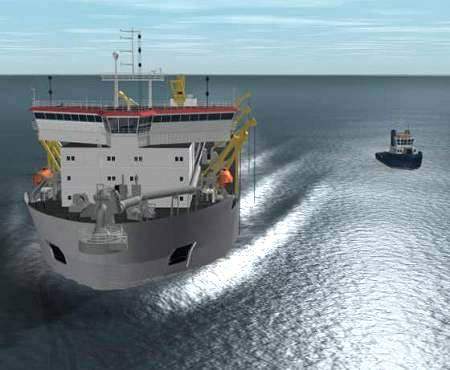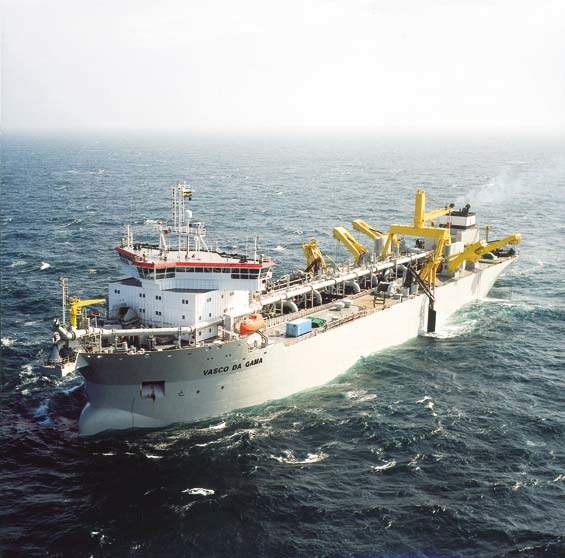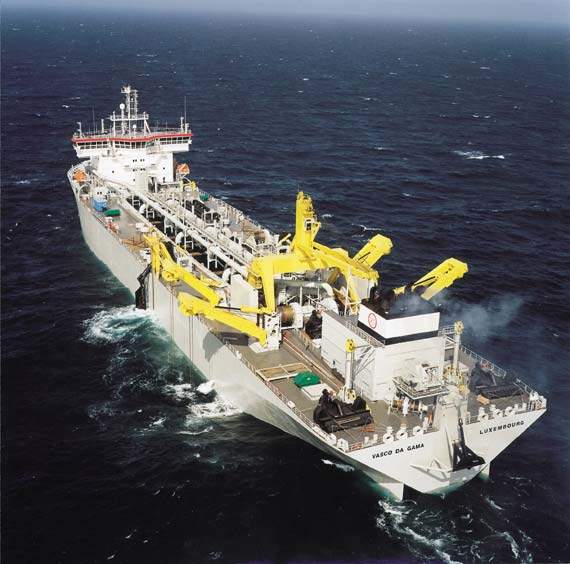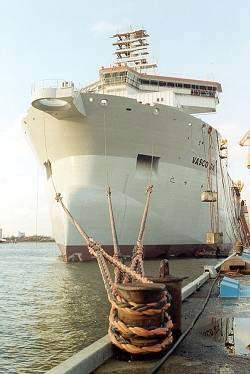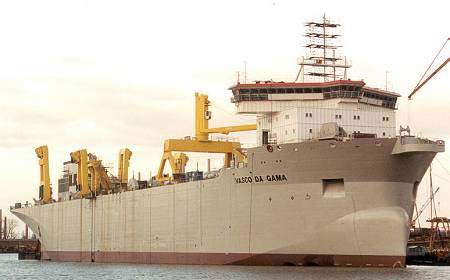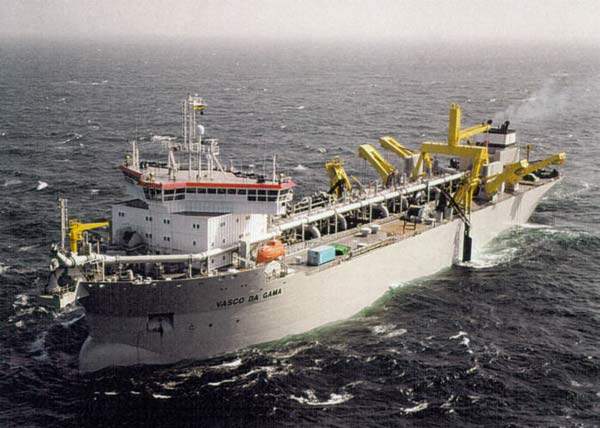The Vasco da Gama is one of the largest suction dredgers in the world. It was built by Thyssen Nordsswerke (hull number 525) for the Belgian group Jan de Nul. It will be used on large-scale land reclamation work and offshore projects such as trenching, pre-sweeping and rock dumping in deep water.
The Vasco da Gama has an overall length of 201m, 178m between perpendiculars and a moulded breadth of 36.2m. It has a V-shaped aft and U-shaped fore body with bulbous bows. It has a design draught of 13m and a dredging freeboard draught of 14.6m. Its deadweight (at 13.45m draught) is 54,600dwt and 60,000dwt at 14.6m draught. It is operated by a complement of 40. The accommodation block is located forward and topped by the wheelhouse.
The ship’s tanks can hold 3,500m³ of heavy oil and 300m³ of diesel oil. For stability, the water ballast system consists of 3,500m³ tanks forward and 1,500m³ aft.
DREDGER OPERATION
Vasco da Gama is capable of working at depths exceeding any other dredger. The dredging itself is carried out by twin 1,400mm side suction pipes with wide drag heads. The suction pipes are raised and lowered using four gantries.
The dredger normally works at depths of 45m to 60m. When the pipes are inclined at an angle of 55°, the vessel is suited to depths of around 80m but with the suction pipes inclined at an angle of 60° and extended, it is possible to increase the working depth to 125m by the use of a 5,500kW submerged dredging pump.
HOPPER CAPACITY
The Vasco da Gama’s vast hopper has a capacity 33,000m³. This results in the suction dredger transporting two to three times the load of many competing vessels each voyage. The dredging pump can fill the hopper in a duration of just one hour.
AFT
The pump room and the suction pipe facilities are located aft of the hopper. The dredge pumps consist of two KF/GIW/44×51 MHD110 units. The dual-function dredge pumps operate at either 4,500kW to draw the spoil from the suction pipes to the hopper or 8,000kW for self-discharge through jet spray/bow coupling. The pumps are driven from the forward end of the main engines via three-speed Jahnel-Kestermann A2S13603S pump gearboxes.
DREDGER ENGINES
The power comes from two Man B&W 14V48160 engines with an output of 14,700kW each at 500rpm. When not used for suction operations, these can be directed at vessel propulsion. The aft end of the engines are linked to Jahne!-Kestermann A1S1520D propulsion gearboxes. These, in turn are connected to two aluminium-copper-nickel controllable pitch Lips propellers located in nozzles attached to the ship. The propellers are 5.5m in diameter and are designed for a rotational speed of 15rpm. The engines give the vessel a speed of a huge 16.5km at a 1,300m draught fully laden with her cargo of dredged material.
The vessel is steered using two fully independent Becker flap rudders. Manoeuvring is assisted by four thrusters. The two Lips bow thrusters have an output of 1,650kW each, while the two Lips stern thrusters have an output of 750kW each. A Simrad Kongsberg Dynamic Positioning (DP) system has been installed.
There is a take-off to 2VEM 12,500kW main engine-driven alternators working at 1,200rpm. In addition, there are also two MAN B&W engines (8L32/40) units, with an output of 3,830kW at 7,200rpm, each of which which are linked to a VEM 3,150kVA alternator and via a Jahnel Kesterman reduction gearbox to a 1,500kW jet pump.
The vessel is classified by Bureau Veritas with the notation 1 3/3 +E Hopper Dredger Deep Sea AUT-MS.

